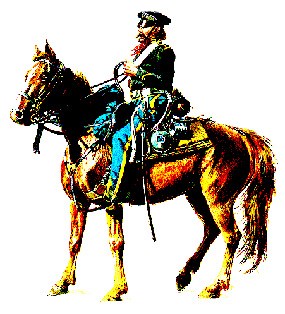
Illustrated by Don Troiani 1. Was there ever a wall or stockade around the fort?
No, there was not. Fort Scott was a peacekeeping fort, there was no real enemy on the frontier at this time, therefore, no need to have a wall or stockade surrounding the buildings. On the treeless prairie the army could see quite a distance, so it would be a mistake to attack a fort on the frontier. Unlike what is seen in the movies, Indians would rarely attack a well-fortified post. The soldiers were here to keep peace between both Indians, settlers and various Indian tribes. Fur trading forts, which housed civilian personnel, were stockaded, but not military forts like Fort Scott, Fort Leavenworth, Fort Riley, Fort Laramie, and Fort Hays.
2. Why are there black buckets hanging on the wall?
With only primitive means of fighting fires, a building fire was a major concern. The black buckets hanging in various rooms were filled with sand or water to extinguish small fires quickly.
3. What buildings are original?
There are 20 historic structures on site – 11 on the buildings contain historic fabric, are considered original buildings, and have been restored. These include the Post Hospital, Officers Quarters 1, 2, and 4, the Quartermaster Storehouse, Bake-House, the Old Stone Building, and Stone Outbuildings. The Carriage Houses were built circa 1855-65 after the fort was first abandoned by the military. The other buildings on site are reconstructions.
4. Were there ever any battles here?
No, there were never any battles at Fort Scott during the early period – 1842-1853. The soldiers were a peacekeeping force. Disturbances were few in number. During the “Bleeding Kansas” years, however, there were numerous threats to the town and it was attacked a few times by free-soilers. The only battles to take place in the area were during the Civil War. The Battle of Drywood, 10 miles east, and Battle of Mine Creek, 20 miles north.
5. Where is the National Cemetery?
The National Cemetery is located on the south end of town about a mile and a half from the fort. Take National Avenue to East National or 17th Street and turn left onto East National. There is a monument at the junction of East National and National Avenues, also a Sonic Drive-In restaurant and Fina Gas Station.
6. What is a Dragoon?
A Dragoon was a mounted soldier or horse soldier. In 1861, United States Dragoons and all of the other mounted units were changed to the more familiar term of Cavalry soldiers. Dragoons were the elite of the U.S. Army and were trained to fight on horseback or dismounted.
7. Was this for North or South in the Civil War?
Fort Scott was garrisoned by Union (Northern) troops during the Civil War. It served as a training center, supply depot, and had a General U.S. Army Hospital and Military Prison.
8. Why do the boxes in the Storehouse say Fort Scott, Missouri?
In order for supplies to get here, the boxes had to read Fort Scott, Missouri. Kansas was not a state as yet (it became a state in 1861). This was considered Indian Territory or unorganized land. Missouri was the closest state.
9. What Indian tribes were around here?
The Osage, Kansa, and Pawnee were the three native tribes to Eastern Kansas. Tribes relocated into the Indian Territory from the East included Cherokee, Creek, and Choctaw to the south, the Miami, New York Indians, Potawatomi, and Ottawa in this area and further north, the Shawnee, Wyandotte, and Delaware.
10. Are those uniforms hot?
Yes, they are hot, but these are the typical uniforms of the period. Wool last longer than any other type of material and the army needed clothing that would not wear out quickly. Also the wool breathes more that other material.
11. What are those boxes of sand?
Spit boxes for tobacco and snuff.
12. What is the crosspiece on the flagpole?
It is there for two reasons. First, it is there for strength to support the upper and lower timbers; and second; many military forts in the 19th century used the design of a ship’s mast for their flagpole because single suitable trees were not tall enough and normally not available on the frontier. Forts on the frontier then copied this tradition. 13. Do you keep horses here all the time?
No, only at certain times during special events. They are owned by our volunteers and help us give visitors a better understanding of life at a frontier fort.
14. Where is your restored tallgrass prairie?
The prairie encompasses 5 acres located on the east side of the grounds and behind the officer’s quarters to the north.
15. What is the range of the cannons?
One half mile to three-fourths mile.
16. What is the range of the small arms?
The flintlock musket and musketoon have an effective range of 50 yards, whereas, the percussion rifle has a range of 150-200 yards. The Enfield rifle has a range of 500 yards.
17. Do you have military records of soldiers that were stationed here in the Civil War?
Yes, mostly of Kansas regiments. Most of the records we do have are hospital records. We also have access to the Internet Civil War Soldiers and Sailors System. |
Last updated: April 10, 2015
